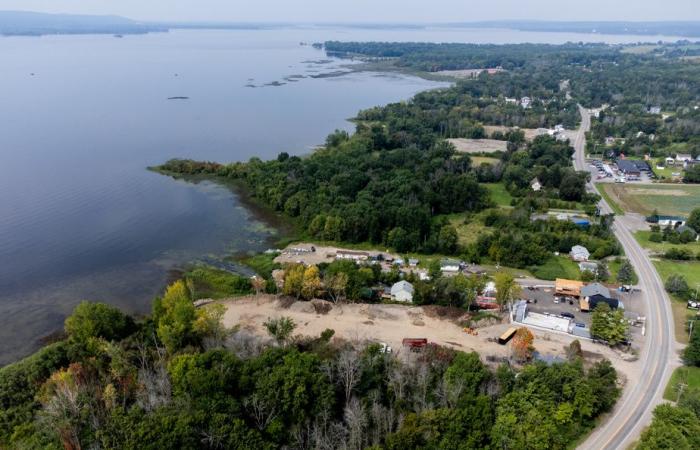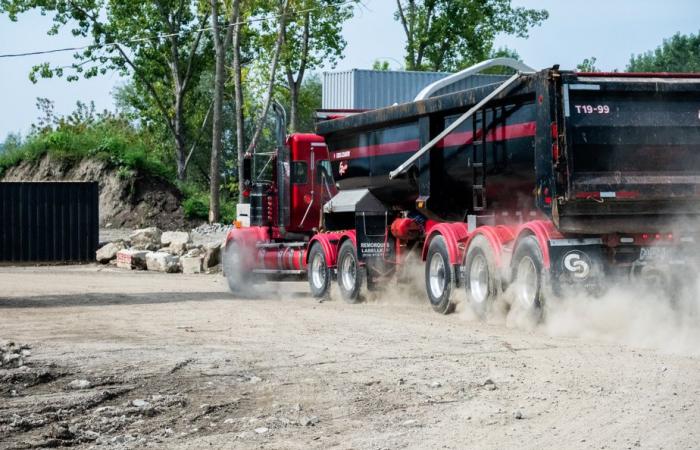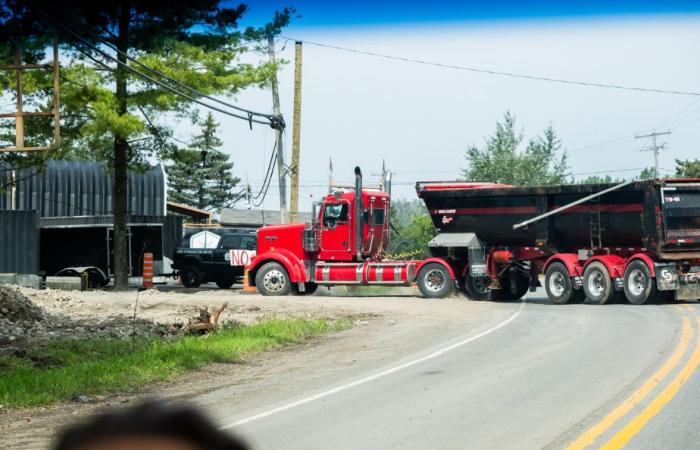“More than 500 trucks per day” are said to have dumped partly contaminated soil in Kanesatake to build cannabis stores in particular. This is according to investigative documents filed in court last week.
Published at 12:42 a.m.
Updated at 5:00 a.m.
“These illegal activities on the shore and the coastline [du lac des Deux Montagnes] constitute a risk to living organisms” and are “a serious threat to the quality of the environment,” state prosecutors state in a request for an injunction in Superior Court.
This emergency legal procedure aims to order an order to stop backfilling and deforestation work on 17 plots of land belonging to the Mohawks of Kanesatake, on the edge of Lac des Deux Montagnes.
Les sols déversés contiendraient des hydrocarbures, selon un rapport d’expertise déposé en preuve.
Certains des chargements de terre versés directement dans le lac ont servi à construire illégalement un stationnement sur le bord de l’eau pour la boutique de cannabis High Times, exploitée par le Mohawk Robert Gabriel, révèlent des résumés d’interrogatoires menés en août dernier par des inspecteurs du ministère de l’Environnement, de la Lutte contre les changements climatiques, de la Faune et des Parcs (MELCC).
Lors d’un interrogatoire, M. Gabriel a fait peu de cas du fait qu’il n’avait aucun permis pour ainsi remblayer la terre « dans l’habitat du poisson ».
C’est notre territoire et aucun gouvernement ne va nous dire quoi faire avec.
Robert Gabriel, répondant à un inspecteur du MELCC qui le questionnait au sujet de déversement de terre près de son commerce High Times
Robert Gabriel est l’un des deux propriétaires, avec son frère Gary, du dépotoir illégal G & R de Kanesatake, dont les eaux toxiques s’écoulent dans le lac des Deux Montagnes. Le MELCC, Environnement Canada et le conseil de bande de Kanesatake tentent depuis des mois – en vain – de l’obliger à entreprendre des travaux de décontamination sur ce site qui a reçu des dizaines de milliers de chargements de terre d’origine douteuse entre 2015 et 2020.
Payé 60 $ par voyage
Un enquêteur du MELCC, Benoît Charette, affirme, dans une déclaration sous serment, que le nombre de camions en direction de Kanesatake atteignait, au printemps 2024, « plus de 500 par jour » et que ceux-ci se déplaçaient « de plus en plus en convois ».
PHOTO CHARLES WILLIAM PELLETIER, ARCHIVES COLLABORATION SPÉCIALE
Un camion entre pour décharger des sols provenant de chantiers de la région de Montréal.
Jean-François Henley, président de Translogik, une entreprise d’excavation embauchée par des propriétaires de terrains mohawks pour étaler le remblai le long du littoral, affirme, dans un interrogatoire, avoir lui-même reçu « 400 ou 500 » camions sur un terrain de Kanesatake à la demande d’un client qui « voulait juste avoir un terrain au bord de l’eau ».
Dans le cadre d’un second interrogatoire, Jean-François Henley a aussi admis avoir reçu entre 500 et 600 camions sur un autre terrain, alors qu’un autre entrepreneur parle de « 300 ou 400 voyages » dans un autre secteur près du littoral.
M. Henley a indiqué qu’il se faisait payer « 60 $ du voyage » par une entreprise d’asphaltage montréalaise qui lui livrait le remblai, dont la provenance n’est pas précisée. Les propriétaires mohawks n’auraient pas payé M. Henley pour les travaux d’étalement du remblai en vertu de cette entente, selon sa déclaration.
Dans un entretien téléphonique avec La Presse, M. Henley défend vivement son entreprise. « Ça fait trois mois que je ne travaille plus [à Kanesatake]. Everything is complicated and everyone passes the buck. »
He gives the example of repeated requests to the band council to ensure that the work respected the distance from Lac des Deux Montagnes.
I have nothing to reproach myself for and even if I am asked to return to work there, I am not going back.
Jean-François Henley, president of Translogik
As a general rule, construction or excavation companies that find themselves with contaminated soil collected during work must dispose of it properly. This may involve processing the material in specialized centers, which can easily charge more than $1,000 per truck, depending on the degree of contamination. Generally, their cargo must be recorded in the Traces Québec system, which allows the location of excavation and the location of unloading to be found by GPS.
However, “sites receiving contaminated soils in the territory of Kanesatake are not registered in the mandatory Traces Québec register of the ministry,” we can read in the court documents.
“Bullyed” inspectors
The approximately 400 pages of toxicological analysis reports and other documents filed as evidence for the request for an injunction suggest the significant difficulties encountered by inspectors in intervening since members of the Mohawk people complained, in the fall of 2023, the incessant ballet of dump trucks.

PHOTO CHARLES WILLIAM PELLETIER, ARCHIVES SPECIAL COLLABORATION
After crossing the municipality of Oka, a truck leaves Rang Sainte-Philomène to enter a site that is backfilling without authorization.
The inspectors “were victims of intimidation during an inspection on the territory of Kanesatake” in September 2023, underlines in a sworn declaration the regional director of environmental control at the MELCC, Alain Rochon. Since that day, each intervention by the MELCC on indigenous territory is carried out in the presence of agents of the Sûreté du Québec, specifies his statement.
“It is in this context that each operation requires a long period of planning” with the Sûreté du Québec and the Mohawk Council of Kanesatake, he adds.
Nicknamed “Operation GRAVIER”, the sampling campaign carried out from August 27 to 30 was initially scheduled to take place in December 2023, but was postponed twice because “the climate does not[était] more conducive to intervention due to security issues,” writes Mr. Rochon.
Impacts on marine fauna
Based on the analyzes of an ecotoxicologist, Quebec maintains that it is necessary to “stop as soon as possible” the filling with contaminated soil because of the direct impact that this can have not only on the environment , but on marine fauna. Unauthorized work on the riparian strip would facilitate land erosion. The rains also risk carrying more soil particles into Lac des Deux Montagnes, reducing the light in the water, which harms the growth of algae and plants. The domino effect on aquatic life doesn’t stop there. The oxygen supply will be reduced and the gas exchanges necessary for aquatic life in the area will be disrupted. Sediments made up of fine minerals could have the effect of clogging the eggs of invertebrates and fish, limiting their reproduction and their chances of survival. The transfer of contaminants into Lac des Deux Montagnes constitutes a risk for organisms and the health of this ecosystem.








